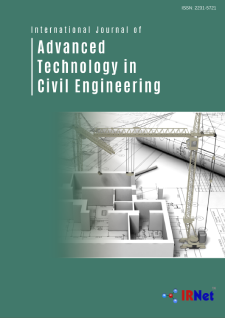International Journal of Advanced Technology in Civil Engineering IJATCE
ISSN: 2231-5721

Abstracting and Indexing


IJATCE
Utilization of steel slag in development of sustainable and durable concrete.
Karthik Prabhu T Dr
Coimbatore Institute of Technology, Coimbatore
Gowri Shankar M Mr.
Coimbatore Institute of Technology, Coimbatore
Jagadesh P Dr.
Coimbatore Institute of Technology, Coimbatore
Nagarajan V Dr.
Coimbatore Institute of Technology, Coimbatore
Abstract
This paper reflects the results of an experimental investigation of the strength, permeability, abrasion, carbonation, and shrinkage characteristics of concrete containing various percentages of steel slag as partial replacement of natural fine aggregates. M 30 Grade concrete was designed as per specific national specifications. Steel slag was used to replace natural sand in the range of 0– 50%. It was observed that the steel slag blended concrete with up to 50% substitution exhibited a comparable compressive and flexural strength when compared to the control specimens. From the Dorry’s abrasion test, it was noted that the specimens could be implemented in heavy-duty floor tiles and even extended to pavement construction. The shrinkage strains, water permeability, and carbonation of steel slag blended concrete were observed to be increasing with increasing replacement amounts of steel slag in the place of natural fine aggregates. The concrete containing steel slag replacing up to 40% of natural fine aggregates can be recommended for all heavy load involving structural applications, and substitution levels beyond 40% could be recommended for non-structural applications, pavements, etc.
Recommended Citation
[1] Mehra, P., Gupta, R. C., Thomas, B. S. (2017). Utilization of copper
tailing in developing sustainable and durable concrete. ASCE Journal
of Materials in Civil Engineering. 2016, 04016274.
[2] Mehra, P., Gupta, R. C., Thomas, B. S. (2016b). Properties of
concrete containing jarosite as a partial substitute for fine aggregate.
J. Cleaner Prod. 120, 241–248.
[3] Furlani, E., Tonello, G., Maschio. S. (2010). Recycling of steel slag
and glass cullet from energy saving lamps by fast firing production of
ceramics. J. Waste management, 30,1714 – 1719.
[4] Carlo Pellegrino., Vittorio Gaddo. (2009). Mechanical and durability
characteristics of concrete containing EAF slag as aggregate. J.
Cement & Concrete composites, 31, 663 – 671.
[5] Hisham Qasrawi. (2014). The use of steel slag aggregate to enhance
the mechanical properties of recycled aggregate concrete and retain
the environment. J. Construction and building materials. 54, 298-304
[6] Dong, B, P. (1999). Treatment and utilization of solid wastes. Beijing,
China. Metallurgical Industry Press, 22–34.
[7] Martys NS (1996). Survey of concrete transport properties and their
measurement. NISTIR 5592, US Department of Commerce. 1–40.
[8] Shaopeng Wu., Yongjie Xue., Qunshan Ye., Yongchun Chen. (2007).
Utilization of steel slag as aggregates for stone mastic asphalt (SMA)
mixtures. J. Building and Environment. 42, 2580-2585.
[9] Yu, P. (1999). Structure of calcium silicate hydrate (C-S-H): near-,
mid-, and far infrared spectroscopy. J. American Ceramic Society. 82,
742–748.
[10] Jagadesh. P., Ramachandramurthy, A., Murugesan, R., Sarayu, K.
(2015). Micro analytical studies on sugar cane bagasse ash. Sadhana –
Academy of science. 40:1629-1638
[11] Gonzalez-Fonteboa, B., Martınez-Abella, F. (2008). Concretes with
aggregates from demolition waste and silica fume. Materials and
mechanical properties. J. Building and Environment, 43, 429– 437.
[12] Jin Liu., Runhua Guo. (2018). Applications of Steel Slag Powder and
Steel Slag Aggregate in Ultra-High Performance Concrete. J.
Advances in Civil Engineering. 18,1-8
[13] Motz, H., Geiseler, J. (2001). Products of steel slags an opportunity to
save natural resources. J. Waste Management. 21, 285-293.
[14] Wang Qiang Yan., Peiyu Yang., Jianwei, Zhang., Bo. (2013).
Influence of steel slag on mechanical properties and durability of
concrete. J. Construction and Building Materials, 47, 1414-1420.
[15] Liu Chunlin., Zha Kunpeng., Chen Depeng. (2011). Possibility of
Concrete Prepared with Steel Slag as Fine and Coarse Aggregates: A
Preliminary Study. J. Procedia Engineering. 24, 412-416.
[16] ASTM. (2009). Standard test method for bulk density (“unit weight”)
and voids in aggregate. ASTM C29/C29M-09, West Conshohocken,
PA.
[17] DIN (Deutsches Institut fur Normung eV). (1991-06). Testing of
hardened concrete (specimens prepared in mould). DIN 1048 Part 5
1991, Germany.
[18] IS 516, BIS (Bureau of Indian Standards). (1959b) Reaffirmed 2004.
Methods of tests for strength of concrete. New Delhi, India
[19] IS 1237, BIS (Bureau of Indian Standards). (2012). Specification for
cement concrete flooring tiles. New Delhi, India.
[20] Caijun Shi (2004). Steel Slag—Its Production, Processing,
Characteristics, and Cementitious Properties, J. Mater. Civ. Eng,
16(3), 230-236.
[21] Shaopeng Wu., Yongjie Xue., Qunshan Ye., Yongchun Chen. (2007).
Utilization of steel slag as aggregates for stone mastic asphalt (SMA)
mixtures. J. Building and Environment. 42, 2580-2585.
[22] Thomas, B. S., Damare, A., Gupta, R. C. (2013). Strength and
durability characteristics of copper tailing concrete. Constr. Build.
Mater. 48, 894–900.
[23] Wang Qiang Yan., Peiyu Yang., Jianwei, Zhang., Bo. (2013).
Influence of steel slag on mechanical properties and durability of
concrete. J. Construction and Building Materials, 47, 1414-1420.